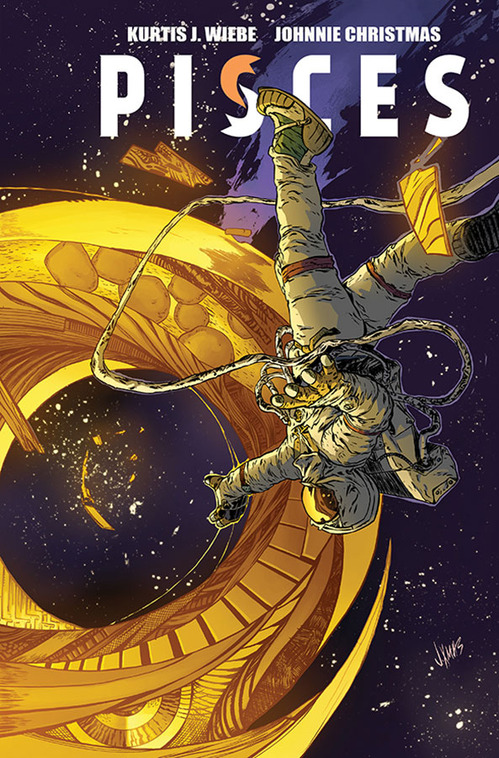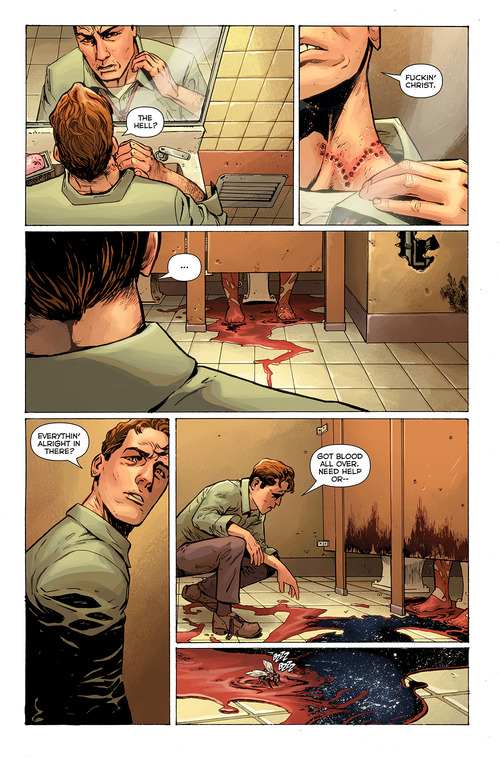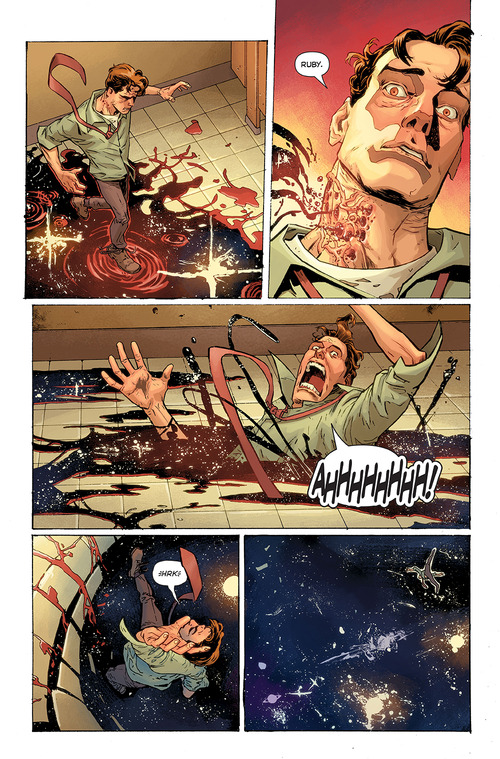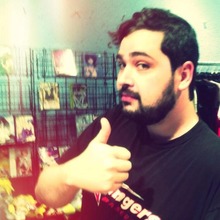Rat Queens may be Kurtis J. Wiebe’s highest profile work to date, but the hardworking writer has been creating original concepts for the last half decade. In 2011, Wiebe launched the Image horror series Green Wake with prolific artist Riley Rossmo, and this week Wiebe returns to the genre with Sheltered artist Johnnie Christmas for Pisces, a labyrinthine tale of psychological body horror set during the Vietnam era.
![]()
With an unsettling first issue and a shocking teaser, Wiebe and Christmas introduce Dillon Carpenter, a traumatized Vietnam vet drafted into a shady space program with menacing ramifications. Paste chatted with Wiebe over e-mail to discuss the series’ long development time, his close working relationship with Christmas and creating a horror story that scares even himself.
Paste: This first issue is intentionally disorienting—you wouldn’t necessarily get a broader sense of the plot without having read solicitation materials or interviews. How did you and Johnnie Christmas decide to kick off the series this way? And will we see the preview with the bar scene incorporated into a future issue, or was that more of a thematic teaser?
Kurtis J. Wiebe: One of the hardest decisions for the series was finding the perfect starting point. We’ve developed the series over the course of two years, and with that amount of time have created a massive universe and timeline to play in. Dip into any part of that vastness and you could find an interesting time in Dillon Carpenter’s life.
We wanted to pick the moment that kicked off every single event in Dillon’s life after the war. The experience that he took home with him. That is where the story begins, and with issue #1, we’re showing the reader Dillon’s life-defining moment, as well as hinting at some other weirdness he will continue to experience throughout the series.

Pisces Art by Johnnie Christmas
Paste: How do his visions of outer space tie into his trauma from Vietnam?
Wiebe: Pisces is a very elaborate puzzle, but one we know the answers to now.
As far as the five page piece that appeared in Previews and online, there may be something similar later on in the series, but that was done specifically to showcase the tone and visuals of the series.
Paste: We know the series is headed into some far-out places, but most of the action in this first issue was grounded either at home or in Vietnam. What kind of balance are you trying to strike between the real and the surreal? Are we going to see a turning point in future issues where things get and stay really crazy?
Wiebe: There will always be a balance to it. This is first and foremost a character study, so the weirdness that happens is grounded in emotion and everything Dillon is experiencing. It’s not odd for the sake of it; there is a metaphor in all the visuals. I think that’s the benefit of having such a long development cycle on this. We’ve been able to do so much work before getting to the actual creating of individual issues.
Paste: Dillon is coping with PTSD following a stint in Vietnam. Did you ever consider setting the story in the modern day and tackling a more recent conflict?
Wiebe: There’s a very specific reason why we chose the era we did and it has to do with the space program in the 1970s. I think there’s also something interesting about that period of American history, where the soldiers were shamed despite having very little say in their involvement, and then the idea that PTSD was something one could just “get over” if they were man enough.
Hell, PTSD wasn’t even coined until a time after the war.

Pisces Art by Johnnie Christmas
Paste: Not too many recent comics have covered Vietnam—The Other Side and Fury MAX are two of the few that come to mind. How much will we see of the actual wartime conflict in the series, and what sort of research did you do to get that aspect right? Were there any particular stories—true or otherwise—that helped inform your take on the experience?
Wiebe: Issue #1 is, for the most part, all we see of it. What we see after is how Vietnam affected him. That’s the important part of Dillon’s story. It’s what happens to him in those brief few days in the jungles of Vietnam that sets him on a particular course for the rest of his life. I watched the Vietnam in HD documentary series to give me an overall idea of the war, as more of a refresher than anything. And I’d done some reading about PTSD in soldiers for my other series Peter Panzerfaust. Though, I have to say, that research was far more applicable to what we’re doing in Pisces than in Panzerfaust.
Paste: You’ve mentioned director David Cronenberg’s body horror as an influence on the series, and I imagine (the 1990 film) Jacob’s Ladder might have come up, too. Even in the otherwise “realistic” Vietnam pages, Christmas’ violence is very visceral and physical, almost reminiscent of the crunching, realistic violence of more recent Cronenberg films.
Wiebe: Whenever I write horror, there has to be a level of discomfort in it for me. Whether it’s facing truths about myself or including themes or visuals that make me uncomfortable, there has to be something in it that makes me want to stop creating it. I can’t even really tell you what bothers me so much about body horror, but Cronenberg’s ‘70s and ‘80s films like Rabid and Videodrome really make my skin crawl. The idea that there’s a horror in the one place you can’t run from, a rotting or corruption from within.
The violence, in the first issue in particular, is brutal because we’re depicting a very horrific event that many soldiers would’ve experienced. We want that image to linger, because it stays with Dillon for his entire life. If it’s difficult for the reader to see, than they will on some level connect with Dillon.
Paste: A frequent discussion point with horror comics is how challenging the pacing can be compared to prose or film—you have less control over the readers’ eyes darting ahead, so you can’t rely on a starting reveal in the same way that a director or prose writer might. How does that affect your scripting process? Or do you worry less about that with certain forms of horror?
Wiebe: It’s all about atmosphere and mood, and it’s the art team that carries that massive weight on their shoulders. Johnnie and Tamra [Bonvillain, the colorist] are doing all the heavy lifting. So much of what is in the script is an explanation of what the viewer needs to feel when moving page to page, and the most I can do is set the frame of mind or the overall mood of the scene. The rest is art.
I think comics is a perfect medium for horror because of that. It’s the way the unnatural can fit in the natural world. We can’t rely on sound or music. It’s all about the whole of the piece maintaining a cohesiveness that builds on a small feeling of dread—that something isn’t quite right.
I also believe that founding the series in emotional honesty, for both me and Johnnie, makes it relatable. If we can make you feel how we feel about the series, then we’ve done our job.
Paste: One of the recurring motifs we’ve seen so far is a pretty ghastly pattern of puncture wounds on the neck. Any teases as to what we’re seeing there?
Wiebe: There’s a running theme of vulnerability that is quietly played out in Pisces. I won’t say much more than that, but good catch! Hah!

Pisces Art by Johnnie Christmas
Paste: Part of what makes your GLAAD Award-winning series Rat Queens so approachable and fun is the interplay between both the immediate cast and the expanded roster of characters, like Braga. Will we see much in the way of a supporting cast for Dillon, or will you be keeping him isolated and off-kilter?
Wiebe: As we go on, we will be building up a cast of characters that are part of Dillon’s everyday life. There needs to be influences, both good and bad. There needs to be personal conflict, or how can we expect Dillon to grow and change… or worse, hide his trauma even more?
There’s the saying, “Hell is other people,” and we plan to explore that quote quite thoroughly.
Paste: Speaking of other people, what is your working relationship with Johnnie like? You mentioned that there are some pages or panels that you describe by the feeling you’re hoping to evoke, and not necessarily with specific instructions. How closely is he involved in plotting and pacing the series?
Wiebe: We’ve been working on this concept for two years. It’s seen a half dozen revisions and probably a dozen tweaks to make sure all the pieces fit. From day one, this has been a complete collaboration. We’ve built and broken down this story together and whenever that happened, we made sure we agreed on major decisions before moving on.
I wrote the final outline and I’m handling the scripting, but it’s only after such a close creative process before getting to that point. Let’s just say that there aren’t any plot surprises coming Johnnie’s way. He knows Pisces equally as well as I do, if not better.
Paste: Colorist Tamra Bonvillain brings a really unique look to the series and a much different atmosphere to Johnnie’s art than what we saw from him in Sheltered. How did you connect with her and how did the team go about establishing this particular look?
Wiebe: Tamra had colored a cover that Johnnie did for Tim Daniel’s Enormous. If I remember correctly, Tim had set that up on his own and Johnnie loved how Tamra realized his inks. She was the first person we contacted to work on Pisces and, thank Christ, she accepted.
Johnnie and Tamra work very closely, with lots of feedback between them as the pages come together. I try to stay the hell out of the way, other than to offer the odd, “Holy shit!” when I see what they’re creating together. Tamra is an absolute essential part of this team and we’re lucky to have her.
Paste: It sounds like the story you have planned for Pisces is vast and likely to surprise a lot of readers as you go along. Do you have a set endgame in mind or is Dillon’s story open-ended?
Wiebe: There’s meaning in the title Pisces. It’s tied to mythology and to Dillon’s journey. While we have an end game for Dillon’s journey, there’s always the possibility that Pisces could take on a whole new identity. A whole new story. New, but old.
How’s that for obscure?
